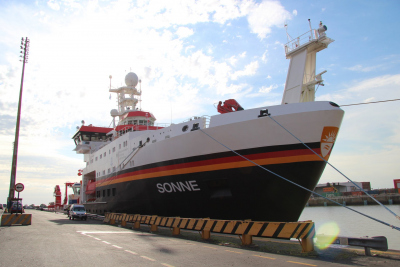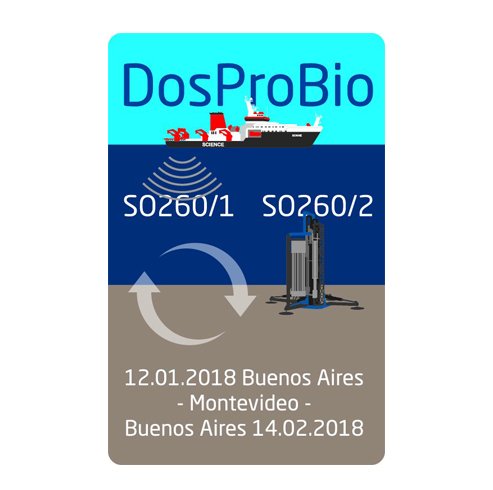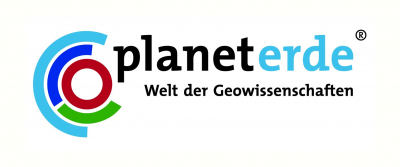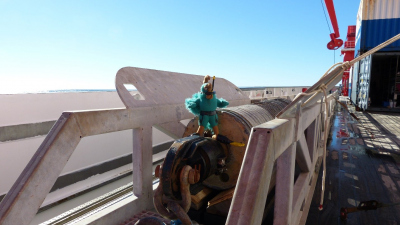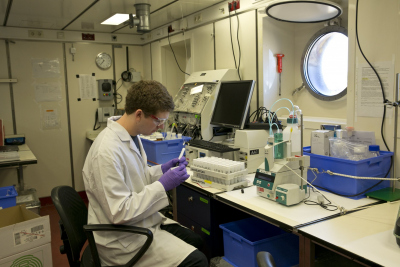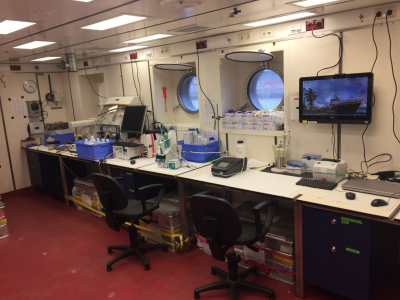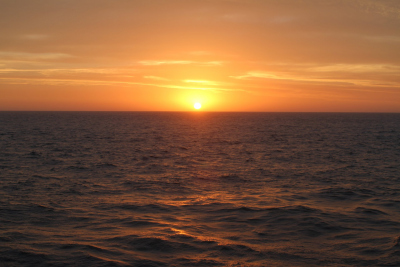- Home
- Discover
- Ship's logs
- Ship's log SONNE SO260
Ship's log SONNE SO260
From 12 January to 14 February 2018, a team of scientists is on an expedition in the Atlantic Ocean with the research vessel (RV) SONNE. The expedition SO260 is a journey of the MARUM – Center for Marine Environmental Sciences at the University of Bremen and is led by Chief Scientist Prof. Dr. Sabine Kasten (Alfred Wegener Institute Helmholtz Center for Polar and Marine Research (AWI) and MARUM project leader) together with Dr. Tilmann Schwenk (Department of Geosciences of the University of Bremen). The researchers are investigating the continental slope off Argentina and Uruguay. Here different ocean currents meet each other, which leads to different sedimentation processes. Among other things, they want to find out how the ocean currents and the different sedimentation systems influence each other, where the deposited material originally comes from and what effects the different sedimentation processes have on biogeochemical reactions and element cycles in the sea floor. Another goal is to understand which microorganisms utilize the deposited material in which way. For this purpose, they survey the sea floor and take water and soil samples, which are further investigated in the on-board laboratories using various methods from geophysics, sedimentology, biogeochemistry, microbiology, and pollen analysis. On the second leg of the journey, the Bremen-based sea floor drill rig MARUM-MeBo70 will also be used to extract samples from deeper and thus older layers of the seabed.
Other institutions involved in the expedition are Oklahoma State University, Coastal Carolina University, the Royal Holloway University of London, Servicio de Hidrografia Naval in Buenos Aires and the Argentinean Navy (Dirección de Investigación y Desarrollo, DGUD).
Here, the researchers report in a ship’s log about life and work on board.
Final ship's log contribution SO260
by Sabine Kasten
On Monday February 12, 2018, we completed the third and last MeBo drill site in the area of the Southern Ewing Terrace at a sediment depth of 20 meters and the MeBo70 drill rig was brought back on deck of the RV SONNE around lunch time. The retrieved sediments were mostly sand with a layer of coarse sand and shell fragments at the base. The remaining station time was used to deploy the gravity corer and the giant box corer in an area where – based on Parasound surveys – we expected a coral mound structure. The 5 meter long sediment core and the sediments retrieved by means of the box corer contained numerous fragments of cold-water corals and sessile fauna at the sediment surface and thus confirmed or assumption.
Coring activities of RV SONNE cruise SO260 were completed February 12 in the late afternoon and we left the working area towards Buenos Aires. After reaching the pilot station located within the inner Rio de la Plata mouth at around 10:00 pm of February 13 we entered port in Buenos Aires at 8 am the next day. After finishing the container loading a reception took place on board of the RV SONNE in the evening of February 16, 2018, on invitation of the German ambassador in Buenos Aires, Jürgen Christian Mertens. Among others the reception was joined by the Argentine parliamentarian Cornelia Schmidt-Liermann (Cambiemos), representatives of MinCyT, of the port authorities and numerous universities and research institutes, the Master of RV AUSTRAL (the former/old SONNE) and ambassadors of several G20 countries (AUS, EU, FRA, GBR, ITA, MEX). After the welcoming speeches of Master Oliver Meyer and Ambassador Mertens as well as a short scientific presentation of RV SONNE expedition SO260 by chief scientist Sabine Kasten, the guests of the reception had the opportunity to tour the ship and talk to members of the crew and the scientific party to find out about research and life onboard the RV SONNE. After the Open Ship Event in January 2018 also this reception was again a great success because of the perfect organization by the ship’s command, the German Embassy in Buenos Aires – in particular by Mrs Kathrin Megerle – the Ship Agency AMI / Ultramar, as well as the wonderful help of the crew and science party.
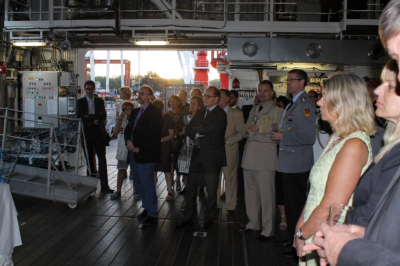
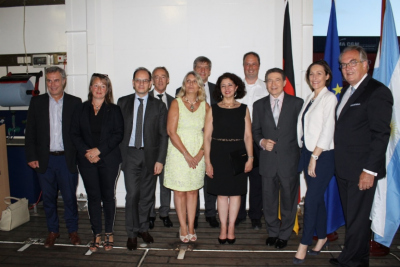
(Photo: German Embassy).
(Foto: Deutsche Botschaft).
On behalf of all scientific cruise participants, I would like to again thank Master Oliver Meyer and the crew of the RV SONNE for their excellent support and helpfulness during cruise SO260. Only with their great help we were able to carry out our research and sampling activities as planned and to collect data and samples of great scientific value. All cruise participants have enjoyed the friendly and supportive atmosphere on board of the ship and for some of them – in particular some of the younger colleagues of whom some were on board of a ship for the very first time – the cruise will be a memorable, lifetime experience.
Greetings from the crew and scientific party of expedition SO260 on the RV SONNE,
Sabine Kasten (Chief Scientist)
The MeBo sediment core “Kurt”
Ship's log contribution by Jessica Volz (AWI)
Hey there, my name is Kurt. I am a MeBo sediment core and I would like to tell you the story of my life. The scientists onboard RV SONNE are currently investigating my neighborhood along the continental slope off Argentina and Uruguay. They want to know where the seafloor sediment material is coming from and how it is deposited at the continental slope. This is not an easy task because different ocean currents meet in this area which influence the sedimentation system even on a km-scale. These dynamics and variabilities in currents and sediment delivery have profound effects on the activity of microorganisms living in the sediment – simply spoken some areas have a wonderful pizza delivery while others have to deal with partly rotten cauliflower. One option to investigate the sedimentary past of my neighborhood is by looking into the sediments using hydroacoustic tools. This very efficient way of imaging the subseafloor is always used to find the perfect spot for the recovery of a beautiful sediment sequence – and here my story begins. While the gravity corer is suitable for the recovery of the upper 12 meter of sediment, the seafloor drill rig MARUM-MeBo70 can ideally recover about 70 meter of sediment. The MARUM-MeBo70 is a transportable drill rig which is remotely operated from the ship’s control cabin and monitored with 7 cameras through copper wires and fiber optics which are connected to the drill rig via a steel armored umbilical. It sounds like a character of the Transformers movies, right? With its capability of sampling sediment cores of 70 meter in length, the MARUM-MeBo70 fills the gap between conventional coring tools such as the gravity corer and proper drill ships that can penetrate several kilometers into the sediment. From previous studies and hydroacoustic surveys during cruise SO260, the scientists found a perfect spot for the deployment of the MARUM-MeBo70 off the coast of Uruguay. Before the drilling can start, 2.5 hours are needed for pre-deployment tests and for the dive to 1390 meter water depth.
After touchdown, the pilots are ready for drilling. The atmosphere in the ship’s control cabin is intense, mostly because of the thrilling music of The Lord of the Rings in the background as Howard Shore’s Uruk-Hais are marching towards Helm’s Deep.

About 48 hours later, all 28 barrels have been drilled and the MARUM-MeBo70 is back on deck. Just like a giant anthill, all scientists, hungry for new sediment material, are mobilized to transport all 2.7 meter long cores into the ship’s hangar where I am sectioned off, carefully labeled, properly taped and cleaned.

The scientists are working hand in hand and after the successful processing of the cores. My first station is the Magnetics lab. Here, I have to pass through a Multi Sensor Core Logger (MSCL) which determines my physical parameters such as magnetic properties, density and porosity. At this station, the scientists finally get to know how much sediment actually was retrieved: 49 sections with a net recovery of 80 % gives a total of 55 meter of sediment – good catch! At the same time a middle part of each section is processed in the Geochemistry lab at chilly 4°C. At these temperatures I feel most comfortable as it resembles the seafloor temperatures. At such great depth there may not be sufficient volumes of pore water – we are talking about ideally 8-10 mL – so it was squeezed out just like orange juice. Back in the hangar, I am being cut open lengthwise in two pieces from which one is used to take sediment samples while the other half is cleaned and prepared for a photo shooting and the core description in the Sedimentology lab.
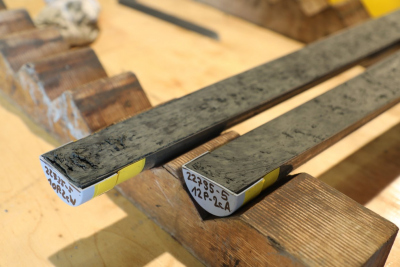
After these numerous stations that I have to pass through over several days, it is finally time to be packed into cozy D-tubes where I will be resting until the end of my days – or until someone would like to have another piece of me.
Microbiology
Ship's log entry by Annika Schnakenberg (University of Bremen and MARUM)
Human kind has investigated only 3 % of the seafloor, which accounts for roughly 70 % of the earth’s surface. Regarding the fact that the oceans combined are the greatest ecosystem on earth, we have gathered very limited knowledge up to date.
The scientists on board of the RV SONNE are trying to change that fact and help us all to understand a little bit more. Very different scientific disciplines are gathered here on this 116 meter long, swimming laboratory anticipating to shed a little more light on the matter. Geophysicists analyse the seafloor surface with hydroacoustic surveys and the magnetic properties of the sediment, sedimentologists and geochemists dissect the structure and geochemical composition of the sediments and palynologists investigate the particles and plankton within the water column. My objective on board is to search for life in the deep sediments.
Although hard to imagine, life is present even 500, 1,000 or 5,000 meter beneath the sea surface. Even deep down in the sediment, kilometres beneath the sea floor scientists have found evidence of life though the organisms are only visible under the microscope. Despite their tiny size these organisms have a huge impact and are therefore of great importance to the entire oceanic ecosystem as well as any other ecosystem on land.
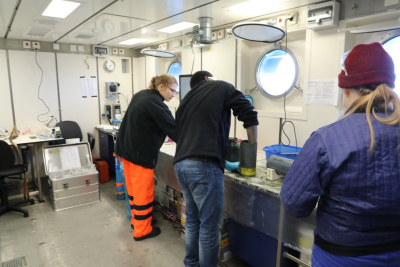
The oxygen in the sediment is depleted already in the uppermost layers, hence forcing the microorganisms in the suboxic zone to rely on alternate electron acceptors to allow for respiration. In order to analyse those microorganisms later in the lab, I take sediment samples from gravity cores (GCs). These consist of up to 12 meter long PVC tubes surrounded by a steel tube whereas a weight of 1,000 kg is placed on top of this construction. The device is deployed vertically to the seafloor while being connected to the mother ship through a steel wire. When it hits the ground its tare weight pressures the GC into the sediment. Back on board, the scientists find themselves holding conserved earth history in their hands. Depending on sedimentation and erosion rates the sediment in hand can be centuries old. The cores are subsequently sliced in halves allowing me together with Dr. Sarah Coffinet (Organic Geochemistry) and David Aromokeye (Microbiology) to take small samples in regular intervals which are stored frozen until further analysis back in lab of Prof. Dr. Michael Friedrich in the University of Bremen. There, I can isolate the DNA to determine the different microbial species and gain an insight into their metabolism and lifestyle. Bacteria and Archaea are highly diverse in terms of their metabolism even regarding respiration. This is a basic metabolism for all forms of life and on dry land it is mainly represented by aerobic (oxygen-dependent) respiration. Within the deep seafloor, on the other hand, where oxygen is depleted, microorganisms need to find alternatives to thrive on.
This is only possible due to alternative terminal electron acceptors such as nitrate, sulphur compounds, methane or even metal oxides and therefore of special interest to microbiologists. First of all, we know that the present atmospheric oxygen concentration was only acquired due to the development of photosynthesis roughly 2.5 billion years ago. Life, on the other hand, has developed long time before at around 4 billion years ago. Hence, the life within the deep, suboxic seafloor aids to understand the original early forms of life.
Moreover, the microbial life in the seafloor is of great importance also nowadays, especially regarding the stability of the global climate. Within the deeper sediment layers microbes constantly produce methane. Before released into the water column and eventually into the atmosphere, methane is trapped and oxidised – once again by microorganisms which form so-called consortia of sulphate-reducing bacteria and methane-oxidising archaea.
The atmospheric methane already accounts for 20 % of global warming and is primarily of anthropogenic origin. But, if all the methane buried in the seafloor were suddenly added to that equation, one would anticipate further warming.
Therefore, it is even more important to human kind to investigate the methane cycle in order to maintain Status Quo and stabilise the oceanic ecosystem. The scientists on board of the RV SONNE provide their contribution by investigating e.g. how and why microorganisms use and produce methane so that all of us will be able to better understand the ocean – the greatest ecosystem on earth.
Sedimentology, Paleoceanography, Geology, and Hydrodynamics
How many 19-year-old students can bundle a major research opportunity aboard a foreign vessel and their first experience leaving their native country all in one bout? For me, this inconceivable opportunity recently became a reality. My name is JT Durica and I am a student from Coastal Carolina University, South Carolina, USA, joining this venture aboard the RV SONNE as a part of the sedimentology/geology group.
In general, we have a large group consisting of 10 members from many different countries all of whom are interested in disciplines ranging from geology and sedimentology to paleoceanography. However, we collaborate with the geochemistry, geomagnetic, and geophysics groups to find interesting locations, collect the cores, and then distribute the cores for sampling which can include pore water analysis, magnetic susceptibility, and much more. Primarily, we work with four different sampling devices including the Gravity Core, Multi Core, Giant Box Corer, and Grab Sampler (GS).
After the locations have been selected, the devices prepared, and the SONNE arrives on station, the frenzy begins as the scientists all stir about in the hanger waiting for each of their respective samples. Usually, each station begins with a Multi Core, Giant Box Core, or the Grab Sampler to check the conditions for the GC, while also preserving the upper section of the sediment column for sampling. These preliminary tests are extremely interesting as they often carry a variety of treasures including numerous stones, creatures of the deep, and piles of coral which the scientists crowd around to try and catch a glimpse.
After the preliminary devices comes the Gravity Core. Our group is responsible for the transportation, labeling, and splitting of the cores before they speed off to the geochemistry and geomagnetic labs. As soon as the two groups are finished, the cores are transported to another location where some are described, and the rest are packed into D-tubes before being taken to a refrigerated container. I guess one could say that we spend a lot of time shuffling cores from one lab to another, on the other hand, I can honestly say I have played more kicker in the past few weeks than I have ever played in my entire life! Even though our days may be full, our group always finds some time to sneak in a few matches of kicker. Whether it is during transits from one station to another or when the Gravity Core has a couple thousand meters to go before it is back on deck, we almost always can be found laughing around the kicker table.
Personally, my job onboard is to assist in the transport of various tools and core tubes, some sampling when needed, cleaning of the devices and work places, as well as the cutting and splitting of the cores. I also got the chance to help with the water column sampling which took place during the night where, under the moonlight, schools of fish and even a shark came to see what was going on. Even though I may not have the largest role in the group, I feel as though I play a major part thanks to everyone’s willingness to include me in their thought processes, observations, and discussions. In addition to the expansive scientific experience, this cruise has been a major cultural adventure for me. It was a large culture shock going from a place where I could understand what everyone is saying to hearing conversations in German, English, Italian, and French. Everything from the food to the dinner table conversations has given me new insights, which I could not get anywhere else. Even if all these different people have such diverse backgrounds, we all have come together as a group in pursuit of greater scientific understanding, which truly is a truly amazing thing. Although this may not be my first expedition aboard a research vessel, this cruise has been one of the most eye-opening and memorable experiences I have had.
Past climate change revealed by geophysics
While some scientists use sediment cores to study the past climate, others use physical instruments to their advantage.
By Antoine Thiéblemont (Ph.D., Royal Holloway University of London) & Dr. Lena Steinmann (University of Bremen)
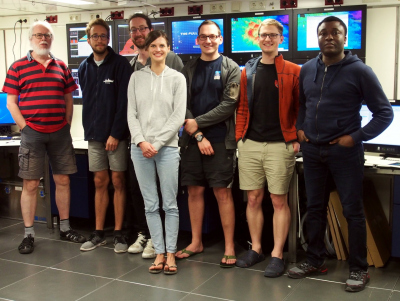
Understanding past climate changes is important as it is central to help us to better understand and, eventually, predict the future. Earth’s climate has changed many times. For example, it has experienced several major ice ages – at least four in the past 500,000 years. During these periods, Earth’s temperature decreased, causing an expansion of ice sheets and glaciers. Scientists look for evidence of past climate change in many different places. One way they have learned about past climate changes is by studying the interaction between bottom currents and sediment deposition around the ‘Mar del Plata Canyon’ in northern Argentina. Most scientists use chemical, paleontological (fossils) or biological evidence of climate change from marine sediments. However, scientists also have non-direct methods to study sediments such as geophysics. During the SONNE 260-1 cruise, an international team of seven geophysicists, led by Prof. Dr. Volkhard Spiess from the University of Bremen, is involved to provide comprehensive information on the topography of the ocean floor as well as its subsurface utilizing multichannel seismic reflection, sediment echosounder, and multibeam echosounder data.
RECORDING AND PROCESSING OF MULTICHANNEL SEISMIC REFLECTION DATA
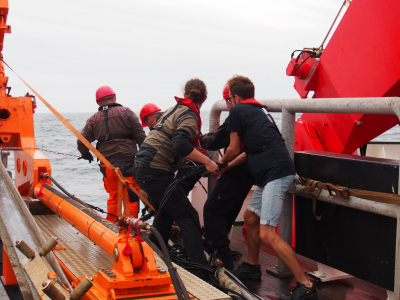
Seismic geophysicists are in charge of the seismic data acquisition, processing and analysis on-board. For the generation of seismic data, an acoustic signal is produced by a seismic source, a so-called GI-Gun, which is towed approximately 30 meters behind the vessel. This signal travels through the water column and sediments and is being reflected wherever changes in the acoustic impedance (being the product of the sediment’s density and seismic velocity) occur. The reflection is then recorded by a receiver cable, the so-called streamer, which comprises 96 receiving units (hydrophones). Simply put, the individual receivers within the streamer act as underwater microphones.
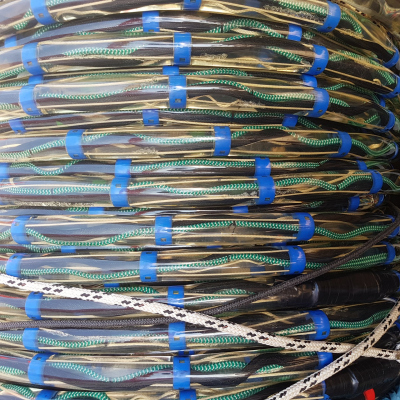
“An optimal acquisition varies according to local conditions and involves employing the appropriate source and optimal configuration of receivers, and orientation of receiver lines with respect to geological features” says Dr. Stefan Wenau, geophysicist at the University of Bremen.
As a result of this method, high-resolution cross-sections through the Earth’s subsurface are generated, providing crucial insights into the depositional system and its changes in response to climate change (e.g. changes in current strength or direction, movement of water mass boundaries). Based on this approach, it is possible to image geological structures down to a subsurface depth of more than one kilometer.
Data are then processed to reduce extraneous effects such as noise.
“It facilitates better interpretation as subsurface structures and reflection geometries become more apparent” says Dr. Lena Steinmann, geophysicist at the University of Bremen.
The resulting data are crucial for the determination of coring sites and, hence, need to be analyzed on the fly during the expedition, which is mainly carried out by the group’s leader Prof. Dr. Volkhard Spiess.
In addition to seismics, Multibeam and Parasound data are collected to provide images of the seafloor topography and very high-resolution cross-sections of the upper 70 meters of the subsurface, respectively. Rouven Brune and Opeyemi Ogunleye, two MSCs of the University of Bremen, are working on the bathymetry data processing, while Fynn Warnke, MSc of the University of Bremen, is mainly dealing with the processing of the Parasound data.
"It's a very diverse field of expertise" Fynn Warnke, MSC of the University of Bremen, says. "It's really rewarding work."
January 21
Hi, my name is Chris Jones, and I am a college student of Oklahoma State University in Stillwater, Oklahoma, USA. You could consider Oklahoma to be an area of transition from the forested area around the Mississippi River to the foothills of the Rocky Mountains. Because of this, there is a very diverse landscape with small mountains, rolling hills, open plains, and wooded river valleys and lakes. One thing that is lacking, however, is a coastline. In fact, this is both my first time on a research vessel as well as my first time on the ocean, and I can not imagine a better way to experience it first. I am a member of the geochemistry group on board, and all the members have been wonderful in helping me adjust to life at sea while also collaborating with me in the lab.
The alarm clock is a particularly ubiquitous harbinger of dread in the working world. But not here. Yes, I love sleep as much as any other college student (it follows just after food on my list), but here it means the start of another day on the RV SONNE. I roll over, climb out of the top bunk, and hop in the shower. Seems pretty normal, right? Imagine doing that while keeping your groggy balance in a box that is constantly rolling and rising with the waves. Breakfast is at 7:00 and often consists of a traditional German dish and a wonderful selection of crisp, fresh fruit as well as standard options such as cereal or yogurt.
Even after just one week it is apparent that life is quite different on the ocean. In the geochemistry group on the RV SONNE, I am experiencing the ocean for the first time not on a Disney cruise, but on a research vessel where I have the privilege to work alongside talented and kind scientists delving into the development of the Argentine Basin.
The work day starts with our geochemistry group meeting at 8:15. Here we discuss the station plan, or what cores or measurements we are going to take today, and which posts each member will work. Does that sound like a recipe for a disaster? Trying to corral a bunch of enthusiastic scientists yearning to get their samples may appear as a challenge, but everyone is, in reality, principally concerned with working together and not impeding the work flow. There follows a day of cutting cores, extracting samples, and analyzing extracted pore water. As part of the biogeochemistry group we are creating profiles for the pore water chemistry, which consist of is the dissolved iron content contrasting the dissolved sulfide content, the pH, Eh, dissolved inorganic carbon, alkalinity, and the presence of certain nutrients in the water such as silica, ammonium, and phosphate. All of these individual aspects together characterize the core from a geochemical perspective, but one of the most interesting facets of being on a multidisciplinary research vessel is seeing the interaction between different scientific fields. For example, I am the group member focused on the sulfide content and got to see first hand how the presence of monosulfides, which appear as black, smudgy looking areas on the core, are actually the transition zone between dissolved iron and dissolved sulfide. That crossover is only one of many; our weekly scientific meetings in the conference room involve discourse about the interplay of geochemical signals and microbiology, sedimentology and how they are the results of sedimentation from the water column as revealed by seismic imaging. The geochemistry, microbiology, sedimentology, water column, and geophysics groups are each a member of one comprehensive expedition attempting to decipher the working of the marine world.
Now, I, a young college student from Oklahoma who has never been on a ship before, get to experience this wonderful, enlightening and ever educational experience each day and end it with a refreshing pause as the sun dips below the horizon. I am still waiting for the flash of green though!
January 11
After an official opening ceremony on January 11, 2018, an Open Ship Event was carried out on board the RV SONNE organized by the German Embassy in Buenos Aires and the Leitstelle Deutsche Forschungsschiffe. Representatives from the Argentine Ministry of Science (MinCyT), the German Embassy in Buenos Aires, the port authority, and numerous universities and research institutes of Argentina participated in the official opening ceremony.
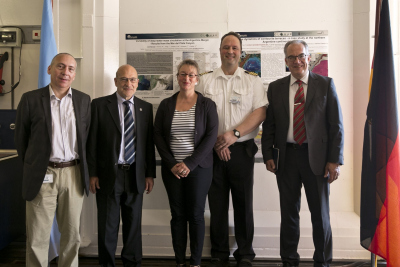
Between 11 am and 5 pm the RV SONNE was open to the public, and about 600 visitors toured the ship and were informed on research and life onboard the RV SONNE. The high participation was remarkable, as there are currently summer holidays in Argentina, and with a temperature around 38°C it was one of the warmest days of the summer. Because of the perfect organization by the ship’s command, the German Embassy in Buenos Aires, the Ship agency AMI / Ultramar, as well as the wonderful help of the crew and science party, the event was a great success. We were all impressed by the great interest the visitors showed towards the ship and our research.



